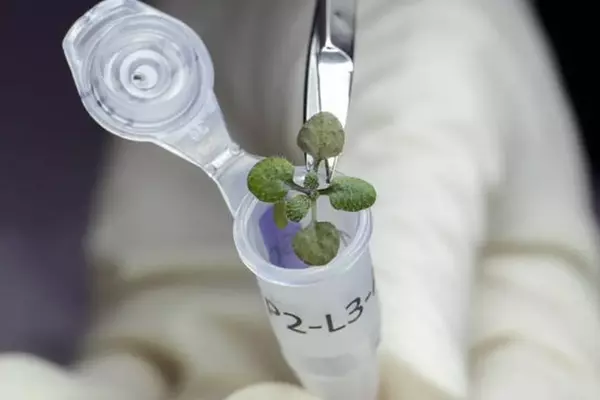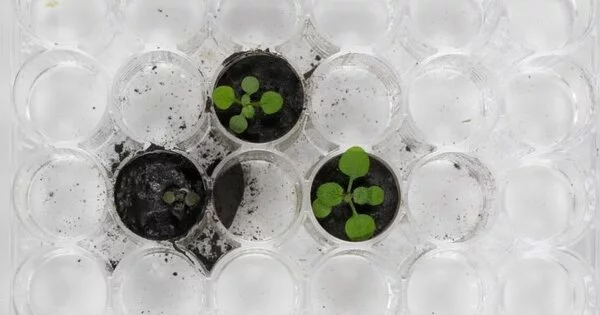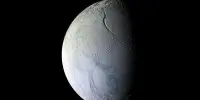Scientists have grown plants on moon soil for the first time. They used soil collected during the Apollo 11, 12, and 17 missions. The researchers wanted to know if plants could grow in lunar soil and, if so, how the plants would react to the unfamiliar environment, down to the level of gene expression.
Scientists have grown plants in soil from the Moon, a first in human history and a watershed moment in lunar and space exploration. The University of Florida researchers demonstrated that plants can successfully sprout and grow in lunar soil in a new paper published in the journal Communications Biology. Their study also investigated how plants respond biologically to the Moon’s soil, also known as lunar regolith, which is radically different from soil found on Earth.
This research is a first step toward one day growing plants for food and oxygen on the Moon or during space missions. More immediately, this research comes as the Artemis Program prepares to return humans to the Moon.
“Artemis will necessitate a better understanding of how to grow plants in space,” said Rob Ferl, one of the study’s authors and a distinguished professor of horticultural sciences at the University of Florida’s Institute of Food and Agricultural Sciences (UF/IFAS).
Even in the early days of lunar exploration, plants played an important role, said Anna-Lisa Paul, also one of the study’s authors and a research professor of horticultural sciences in UF/IFAS. “Plants helped establish that the soil samples brought back from the moon did not harbor pathogens or other unknown components that would harm terrestrial life, but those plants were only dusted with the lunar regolith and were never actually grown in it,” Paul said.
We may use the Moon as a hub or launch pad for future, longer-duration space missions. It makes sense that we would want to grow plants in the soil that is already there. So, what happens when you grow plants in lunar soil, which is completely foreign to a plant’s evolutionary experience? In a lunar greenhouse, what would plants do?
Rob Ferl
Paul and Ferl are world-renowned experts in the study of plants in space. They have sent experiments on space shuttles, to the International Space Station, and on suborbital flights via the UF Space Plants Lab.
“We may use the Moon as a hub or launch pad for future, longer-duration space missions. It makes sense that we would want to grow plants in the soil that is already there “Ferl stated. “So, what happens when you grow plants in lunar soil, which is completely foreign to a plant’s evolutionary experience? In a lunar greenhouse, what would plants do? Could there be lunar farmers?”
To begin to answer these questions, Ferl and Paul designed a deceptively simple experiment: plant seeds in lunar soil, add water, nutrients and light, and record the results.
The catch: The scientists only had 12 grams (a few teaspoons) of lunar soil to work with for this experiment. This soil was collected during the Apollo 11, 12, and 17 missions to the Moon and is on loan from NASA. Over the course of 11 years, Paul and Ferl applied three times for a chance to work with the lunar regolith.
Because of the small amount of soil, as well as its incalculable historical and scientific significance, Paul and Ferl had to devise a small-scale, meticulously choreographed experiment. The researchers grew their tiny lunar garden in thimble-sized wells in plastic plates normally used to culture cells. Each well served as a pot. Once they filled each “pot” with approximately a gram of lunar soil, the scientists moistened the soil with a nutrient solution and added a few seeds from the Arabidopsis plant.

Arabidopsis is widely used in the plant sciences because its genetic code has been fully mapped. Growing Arabidopsis in the lunar soil allowed the researchers more insight into how the soil affected the plants, down to the level of gene expression.
The researchers also planted Arabidopsis in JSC-1A, a terrestrial substance that mimics real lunar soil, as well as simulated Martian soils and terrestrial soils from extreme environments, as a point of comparison. The plants grown in these non-lunar soils served as the control group for the experiment. The researchers were unsure whether the seeds planted in the lunar soils would sprout prior to the experiment. But almost all of them did.
“We were astounded. That was not predicted by us” Paul stated. “This indicated that the lunar soils did not interfere with plant germination hormones and signals.” However, the researchers noticed differences between the plants grown in lunar soil and the control group over time. For example, some of the plants grown in the lunar soils were smaller, grew more slowly or were more varied in size than their counterparts.
These were all physical signs that the plants were working to cope with the chemical and structural make-up of the Moon’s soil, Paul explained. This was further confirmed when the researchers analyzed the plants’ gene expression patterns.
“At the genetic level, the plants were pulling out the tools typically used to cope with stressors, such as salt and metals or oxidative stress, so we can infer that the plants perceive the lunar soil environment as stressful,” Paul said. “Ultimately, we would like to use the gene expression data to help address how we can ameliorate the stress responses to the level where plants — particularly crops — are able to grow in lunar soil with very little impact to their health.”
According to Ferl and Paul, who worked on the study with Stephen Elardo, an assistant professor of geology at UF, how plants respond to lunar soil may be linked to where the soil was collected. For example, the researchers discovered that the plants that showed the most signs of stress were those grown in what lunar geologists refer to as mature lunar soil. These mature soils have been exposed to more cosmic wind, which has altered their composition. Plants grown in less mature soils, on the other hand, fared better.
Growing plants in lunar soils may also change the soils themselves, Elardo said.
“The Moon is an extremely dry environment. How will the minerals in the lunar soil react to the addition of water and nutrients from a plant? Will adding water make the mineralogy more plant-friendly?” Elardo stated.
These and other questions will be addressed in subsequent studies. For the time being, scientists are ecstatic about taking the first steps toward growing plants on the Moon. “We wanted to do this experiment because we had been wondering for years whether plants could grow in lunar soil,” Ferl explained. “It turns out that the answer is yes.”
















